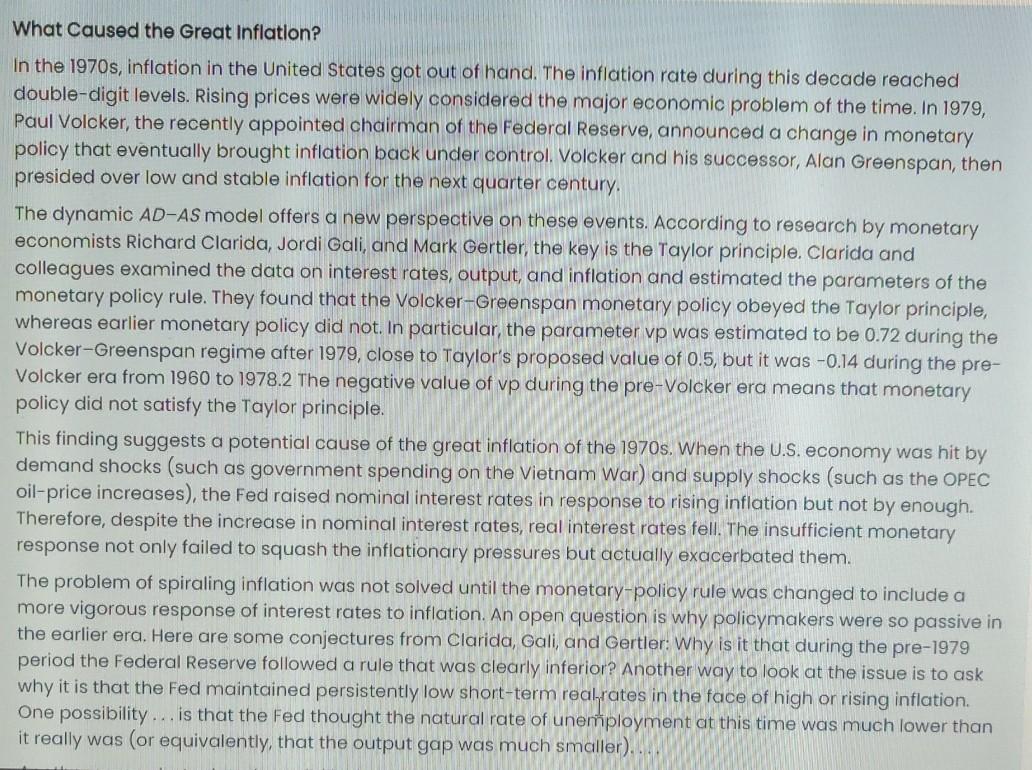Answered step by step
Verified Expert Solution
Question
1 Approved Answer
What Caused the Great Inflation? In the 1970s, inflation in the United States got out of hand. The inflation rate during this decade reached


What Caused the Great Inflation? In the 1970s, inflation in the United States got out of hand. The inflation rate during this decade reached double-digit levels. Rising prices were widely considered the major economic problem of the time. In 1979, Paul Volcker, the recently appointed chairman of the Federal Reserve, announced a change in monetary policy that eventually brought inflation back under control. Volcker and his successor, Alan Greenspan, then presided over low and stable inflation for the next quarter century. The dynamic AD-AS model offers a new perspective on these events. According to research by monetary economists Richard Clarida, Jordi Gali, and Mark Gertler, the key is the Taylor principle. Clarida and colleagues examined the data on interest rates, output, and inflation and estimated the parameters of the monetary policy rule. They found that the Volcker-Greenspan monetary policy obeyed the Taylor principle, whereas earlier monetary policy did not. In particular, the parameter vp was estimated to be 0.72 during the Volcker-Greenspan regime after 1979, close to Taylor's proposed value of 0.5, but it was -0.14 during the pre- Volcker era from 1960 to 1978.2 The negative value of vp during the pre-Volcker era means that monetary policy did not satisfy the Taylor principle. This finding suggests a potential cause of the great inflation of the 1970s. When the U.S. economy was hit by demand shocks (such as government spending on the Vietnam War) and supply shocks (such as the OPEC oil-price increases), the Fed raised nominal interest rates in response to rising inflation but not by enough. Therefore, despite the increase in nominal interest rates, real interest rates fell. The insufficient monetary response not only failed to squash the inflationary pressures but actually exacerbated them. The problem of spiraling inflation was not solved until the monetary-policy rule was changed to include a more vigorous response of interest rates to inflation. An open question is why policymakers were so passive in the earlier era. Here are some conjectures from Clarida, Gali, and Gertler: Why is it that during the pre-1979 period the Federal Reserve followed a rule that was clearly inferior? Another way to look at the issue is to ask why it is that the Fed maintained persistently low short-term realrates in the face of high or rising inflation. One possibility... is that the Fed thought the natural rate of unemployment at this time was much lower than it really was (or equivalently, that the output gap was much smaller). Another somewhat related possibility is that, at that time, neither the Fed nor the economics profession understood the dynamics of inflation very well. Indeed, it was not until the mid-to-late 1970s that intermediate textbooks began emphasizing the absence of a long-run trade-off between inflation and output. The ideas that expectations may matter in generating inflation and that credibility is important in policymaking were simply not well established during that era. What all this suggests is that in understanding historical economic behaviour, it is important to take into account the state of policymakers' knowledge of the economy and how it may have evolved over time. Answer the following questions 1. Explain demand shock and supply shock in relation to inflation and the case study? (7 marks) 2. Why it is that the Fed maintained persistently low short-term real rates in the face of high or rising inflation. Justify your answer in relation with the inflation situation in 1970's? (8 marks)
Step by Step Solution
★★★★★
3.45 Rating (155 Votes )
There are 3 Steps involved in it
Step: 1
1 Demand Shock and Supply Shock in Relation to Inflation and the Case Study Demand Shock A demand shock occurs when there is a sudden and unexpected c...
Get Instant Access to Expert-Tailored Solutions
See step-by-step solutions with expert insights and AI powered tools for academic success
Step: 2

Step: 3

Ace Your Homework with AI
Get the answers you need in no time with our AI-driven, step-by-step assistance
Get Started


